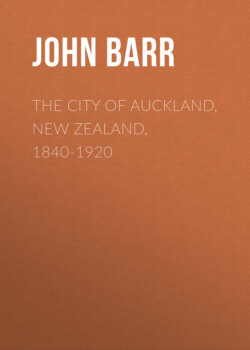The City of Auckland, New Zealand, 1840-1920

Реклама. ООО «ЛитРес», ИНН: 7719571260.
Оглавление
John Barr. The City of Auckland, New Zealand, 1840-1920
The City of Auckland, New Zealand, 1840-1920
Table of Contents
THE CITY OF AUCKLAND. Foreword
Preface
Correction
THE MAORI HISTORY OF THE. AUCKLAND ISTHMUS (Tamaki-Makau-Rau)
I. Introduction
THE EARLIEST INHABITANTS OF TAMAKI
III. The Arrival of the Fleet—1350 A.D
IV. The Tainui Canoe
V. The Arawa Canoe
VI. The Matatua Canoe
VII. The Aotea Canoe
VIII. Ancient Maori Society—A Retrospect
IX. The Wars of Tamaki
MAKI’S INVASION FROM WAIKATO
KAWHARU’S INVASION FROM KAIPARA
WARS WITH HAURAKI GULF TRIBES
THE MURDER OF KAHURAUTAO
KAPETAWA’S INVASION
X. Kiwi Tamaki (1720-1750)
XI. The Ngati-Whatua Era in Tamaki
XII. The Nineteenth Century (1800-1840)
MARSDEN’S VISIT
CRUISE’S VISIT TO TAMAKI, 1820
TE KOPERU’S INVASION
HONGI’S INVASION
D’URVILLE’S VISIT
NGAPUHI DEFEATED AT TAMAKI HEADS
THE COMING OF CHRISTIANITY
THE CITY OF AUCKLAND. NEW ZEALAND. 1840-1920
Chapter I. Foundation and Settlement (1840-1850)
Price of Provisions at Auckland, July, 1841
Rents and Lodging
Wages
Chapter II. Development: 1851-1870
Chapter III. Progress and a Slump: 1871-1900
Chapter IV. Prosperity and Expansion: 1901-1920
Postscript
Appendix I. The Name of Auckland
Appendix II. Population of the City of Auckland
Appendix III. Table Showing Imports and Exports at the Port of Auckland: 1853-1920
Footnote
Index
Отрывок из книги
John Barr
Published by Good Press, 2021
.....
The crops grown were the “taro,” “hue” (gourd), “uwhi” (yam), and “kumara.” This latter was indeed the “staff of life,” and its cultivation occupied much of the time and industry of the people. At harvest time these crops were gathered into the store-houses and pits for winter use.
At early dawn the people were astir and about their daily duties. After the morning meal, the cultivators went forth to the plantations, the fishers to the sea, and the hunters to the forest. Other men were engaged in the building of houses or canoes, in which the art of the carver was utilised, or in the making of stone implements or weapons, whilst the women of rank directed and actively took part in the domestic arts—garment weaving, mat and kit plaiting, etc.
.....